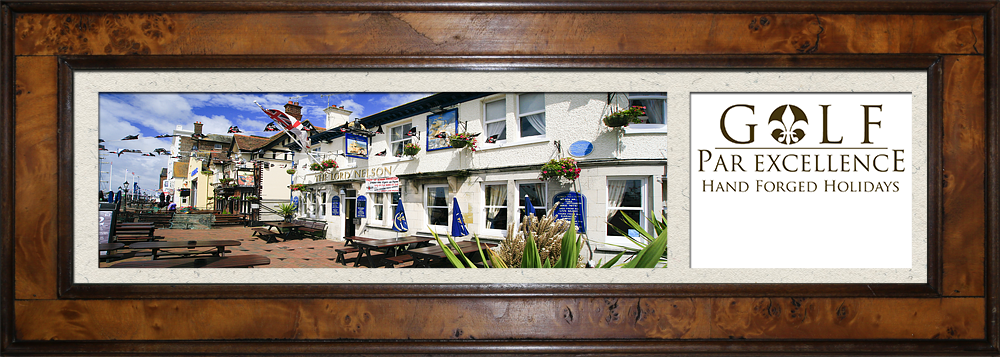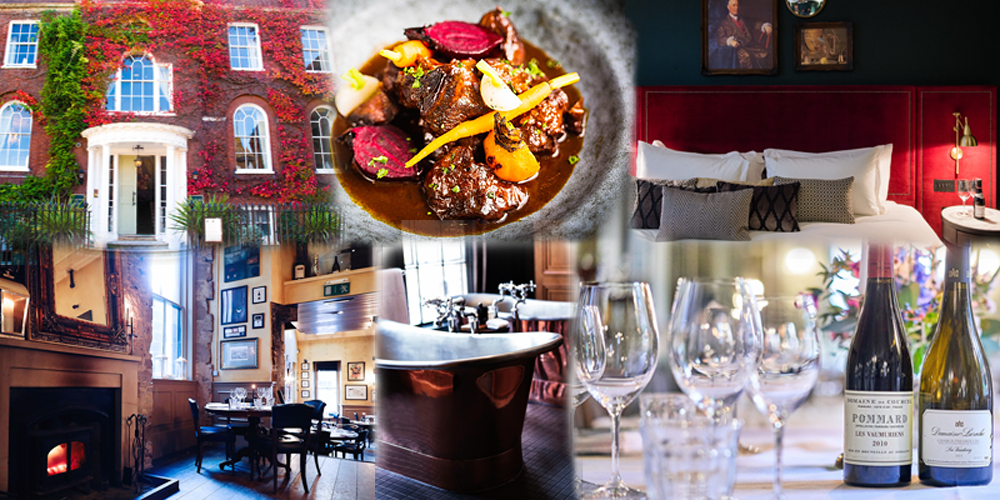The discerning Hotel du Vin group runs bijou town-centre hotels (with brasseries) spread across the UK - many in well-known golfing locations
such as St. Andrews, Poole, Glasgow and Edinburgh.
There are others too where you can enjoy charming English country towns combined with undiscovered (hence excellent value) golf courses
such as: Stratford-upon-Avon, Tunbridge Wells, Cheltenham, Brighton, Henley-on-Thames, York and Cambridge.
Below are a few specials that we have created to give you an idea of
what is possible; all are based on three-nights and two rounds: needless to say, we can cater for whatever length of stay you would prefer -
just ask!
Hotel du Vin - Poole
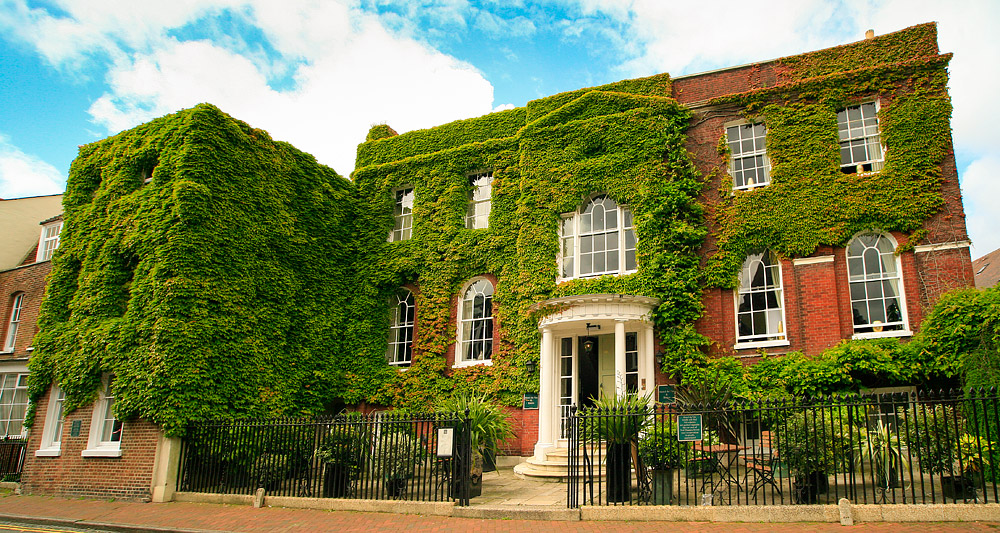
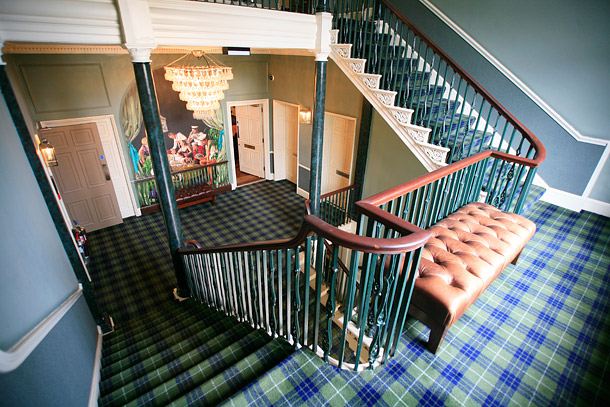
The smartest hotel in Poole without a doubt. The Hotel du Vin offers a very comfortable base for your Dorset golfbreak, sitting right in the centre of Poole from where you can stroll the quayside and the High Street shops and cafés at your ease.
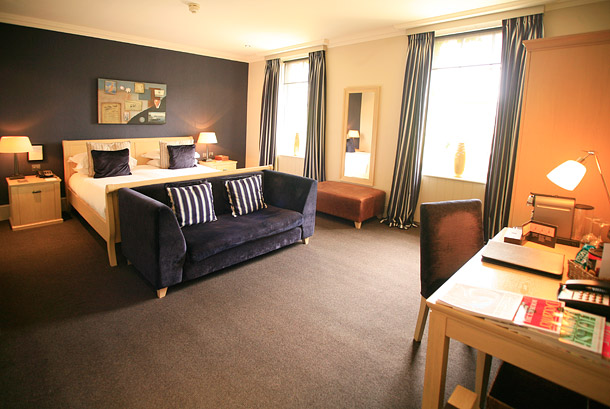
The Hotel du Vin is a successful group of hotels that aspire to a superior level of elegance and charm: they achieve their aspirations in a traditional style in keeping with their French connections. You will notice this on arrival and when you are shown to your classically decorated and furnished bedroom with their modern bathrooms.
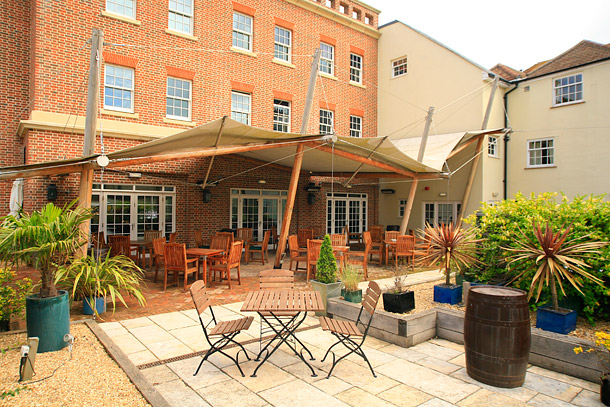
In addition to the charming interior, there is a small garden at the rear of the hotel for quiet moments en plein air - perhaps with a refreshment from the waiter-service bar?
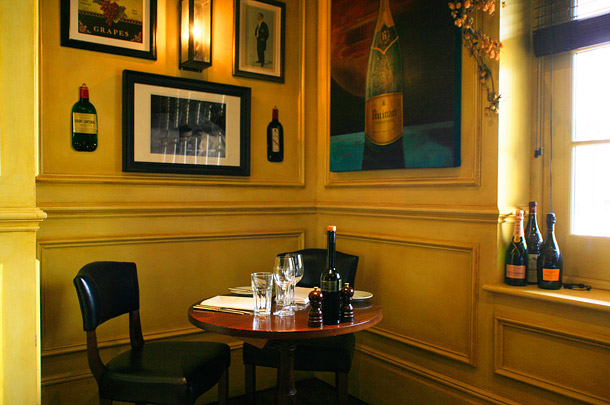
Victuals are vitally important at the Hotel du Vin, where they take great pride in their brasserie style menu and service. If you wish to dine out there are plenty of other restaurants in Poole too and, as always, we shall start you off with a few of our recommendations to chew over. Being a 'wine hotel' there is an extensive choice of fine wines to choose from and if you are serious about the subject, tastings can be arranged in their atmospheric cellar.
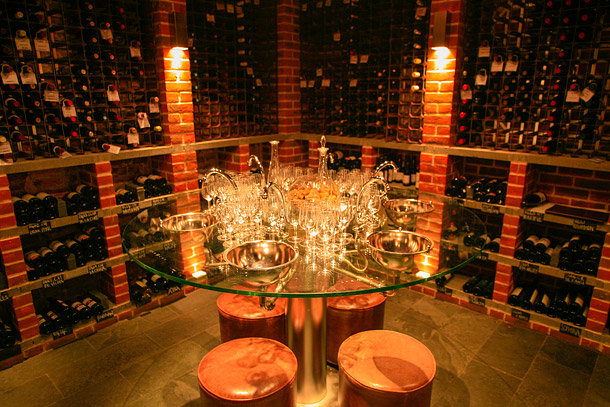
Poole Golf Clubs
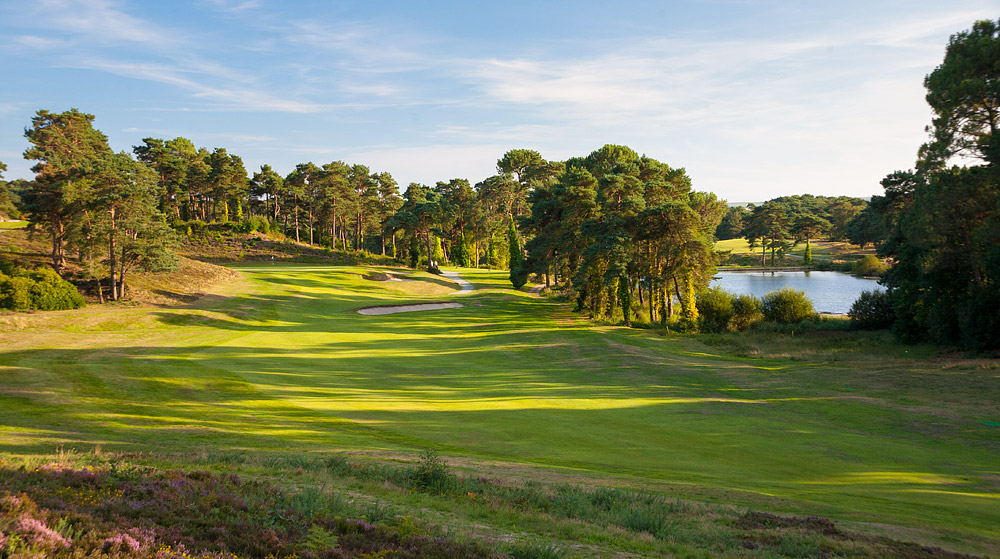 Parkstone Architect: W. Park & J. Braid (1910) 18 holes: 6,282yds: par 72.
Parkstone Architect: W. Park & J. Braid (1910) 18 holes: 6,282yds: par 72.
Hard to imagine that in the backstreets between Poole and Bournemouth lurks one of England's finest (and possibly tightest!) parkland courses. How the land survived the developer's shovel is hard to know but thank the Lord it did! Parkstone enjoys perfect golfing terrain: rises and dips across three distinct ridges through the tall pines and between the rhododendrons and lakes - even a glimpse of The Channel from some of the elevated spots. The course layout sits beautifully into its setting, making the most of the natural hazards and shapes with just a few carefully added bunkers here-and-there. Not to be missed.

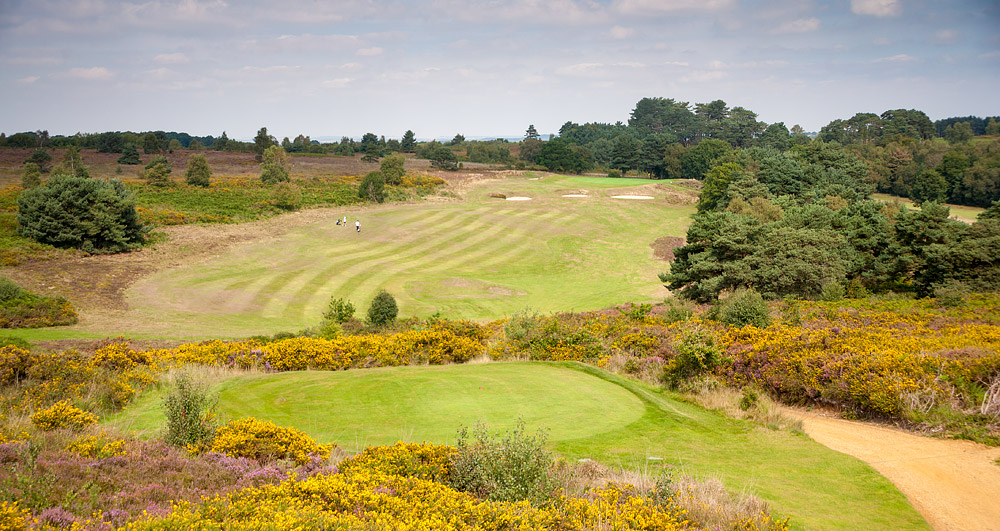 Broadstone Architect: T. Dunn (1898) 18 holes: 6,419yds: par 70.
Broadstone Architect: T. Dunn (1898) 18 holes: 6,419yds: par 70.
Broadstone is a wild ride across hillsides clad with heather and gorse: if you didn't know better you would swear you were in the Scottish Highlands! The course itself clambers up and down the slopes although the majority of holes are pretty level with exertion required from Green to Tee. The course occupies a broad expanse of land so holes are generally well separated from each other and any buildings or roads: a peaceful game is ensured. Broadstone is a great test of golf.

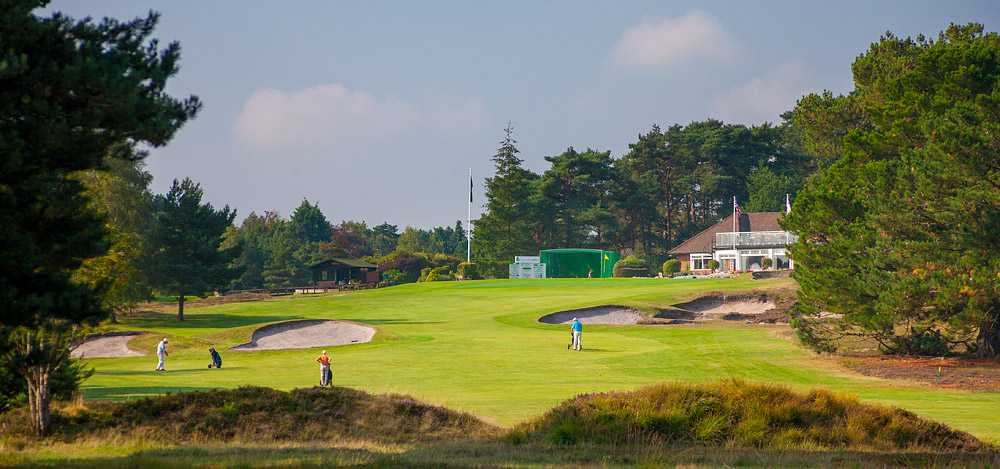 Ferndown Architect: H. Hilton (1914) 18 + 9 holes: 6,453yds: par 71.
Ferndown Architect: H. Hilton (1914) 18 + 9 holes: 6,453yds: par 71.
A contender for the prettiest course in England without a shadow of a doubt, but a serious golf course too. Ferndown's Clubhouse is encircled by fantastical flowerbeds bursting with colour; beyond lies a carpet of purple heather that sprawls out in all directions across every corner of the golf course that lies below. Fairways at Ferndown are not to be missed or you will find yourself battling with the dreaded heather! The course layout is challenging and attractive in equal measure: intelligent Fairway bunkering engenders a little thought on many Tees and the dog-legs require good judgement to avoid being blocked-out by the pines. The terrain is pretty flat, so you may have enough energy left to take on the nine-hole 'Presidents' course after lunch?

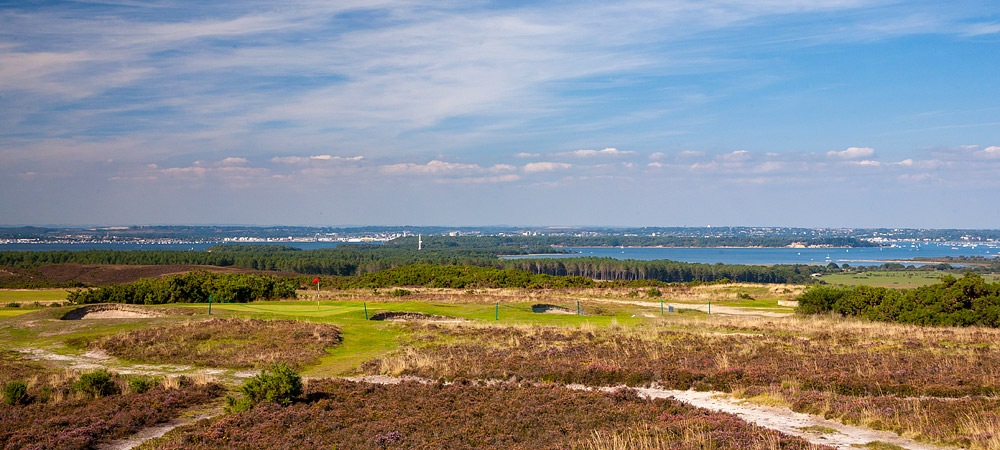 Isle of Purbeck Architect: H. Colt (1892) 18 holes: 6,295yds: par 70.
Isle of Purbeck Architect: H. Colt (1892) 18 holes: 6,295yds: par 70.
The golf course on the Isle of Purbeck is a thing of great natural beauty and a reminder of how golf used to be before pesticides and fertilizers were gaily scattered around (and perhaps how golf will be again, once they are no longer permissible?). The course sits on Studland Head overlooking the bay and across to Sandbanks and Poole beyond. Exposed to the sea-breezes, Islo of Purbeck has a rugged appeal: not really pure links golf, more seaside-heathland with its open reaches of heather and gorse - a sanctuary to endangered wildlife. A very friendly welcome awaits you in the Clubhouse before and after your round - in many ways it epitomises Dorset golf.

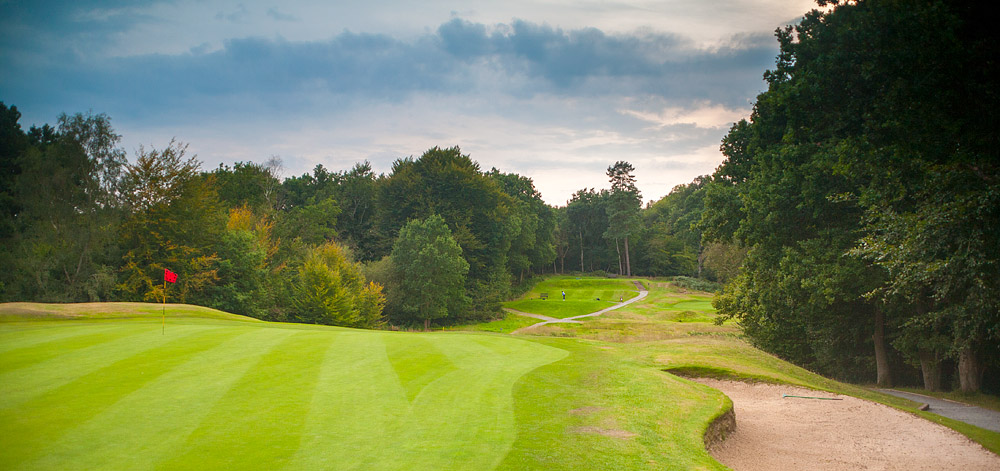 Brokenhurst Manor Architect: H. Colt (1919) 18 holes: 6,222yds: par 70.
Brokenhurst Manor Architect: H. Colt (1919) 18 holes: 6,222yds: par 70.
Breaking out of Dorset into the heart of the New Forest, Brokenhurst Manor is a tranquil course where the game is all about keeping out of the New Forest! The holes are isolated from each other by the dense dark woods, so all you will hear on your way around is your playing partners and birdsong. Perhaps a little too far from Poole or Bournemouth for a day's golf but well worth a stop to break your journey to or from a Dorset golf holiday.

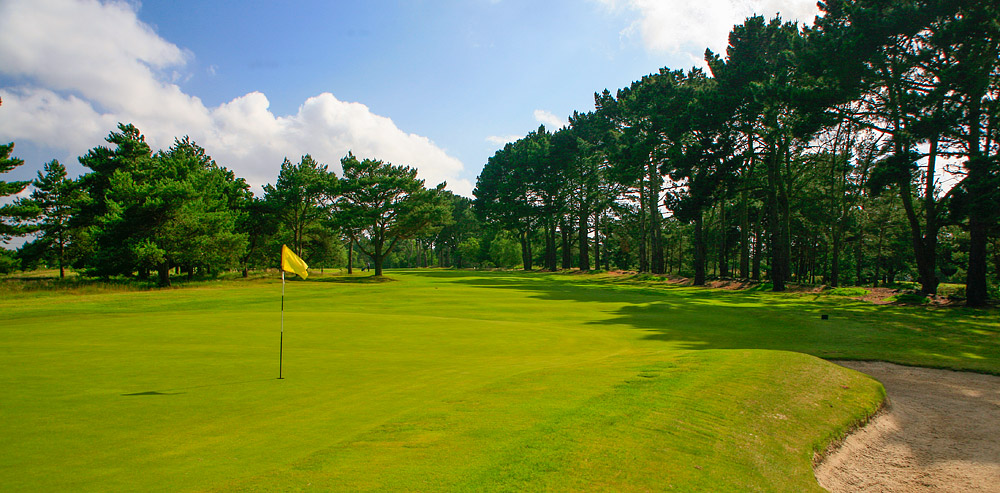 Knighton Heath Architect: S. Gidman (1904) 18 holes: 5,838yds: par 70.
Knighton Heath Architect: S. Gidman (1904) 18 holes: 5,838yds: par 70.
A very friendly (and very good value) local's Golf Club that is also very close to the centre of Poole. An oasis of greenery atop a rounded hill, not far from all the chimmney pots, where you can escape and enjoy a not-too-taxing round of golf. Holes have been well thought out around the hill and through the established trees and make the most of the gentle slopes of the landscape without ever becoming strenuous. Well looked after, it should not be discounted on any golf trip to Dorset.

Other courses to consider
Meyrick Park - A public course crafted by Tom Dunn way back in 1894 (resculpted by Sir Henry Cotton in 1924) that has stood the test of time; Common Land so lots of walkers (especially at weekends) a good test nevertheless and of interest to any golfing historians as it's the oldest public course in England.

Hotel du Vin - York
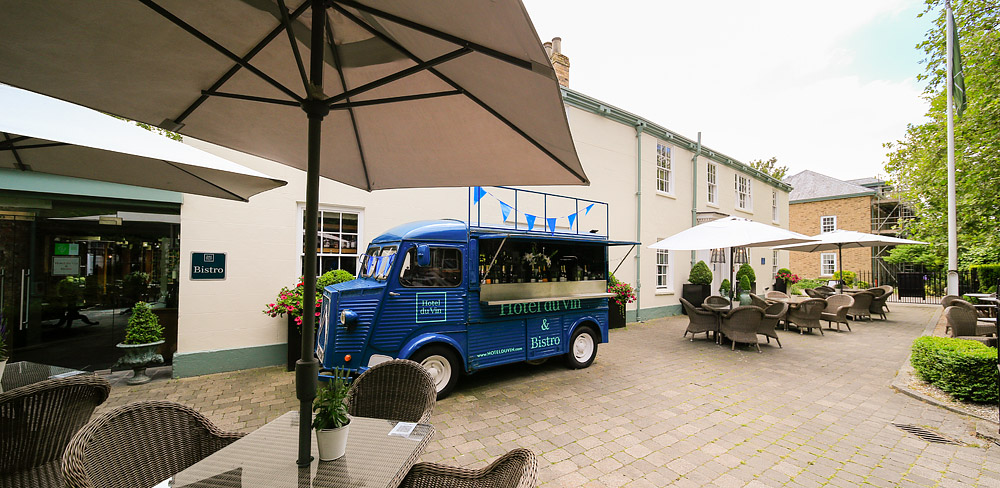
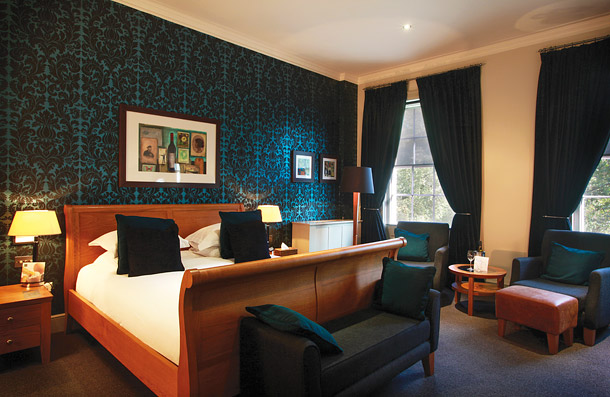
The Hotel du Vin in York is situated by Michaelgate, close to the old part of town where you will find the narrow, medieval lanes crammed with tea-shops, pubs and restaurants: exactly where you want to be!
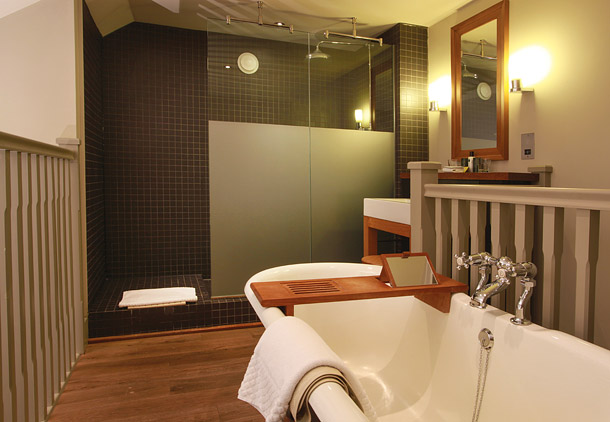
The Hotel du Vin is one of the fine old buildings of York: converted from a 19th Century orphanage. It has 44 sylish rooms, each individually furnished and decorated with only class in common: the Suites are delightful and worth a little extra. Your stay in York will be very comfortable here.
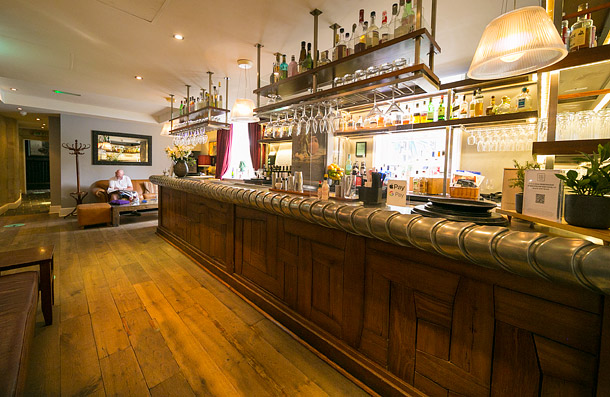
Before dinner enjoy a relaxing drink in the hotel's bar, with a long wine list or maybe a cocktail? If you're serious about your wine selection for dinner have a chat with the sommelier - always keen to advise and discuss pairings with the current menu.
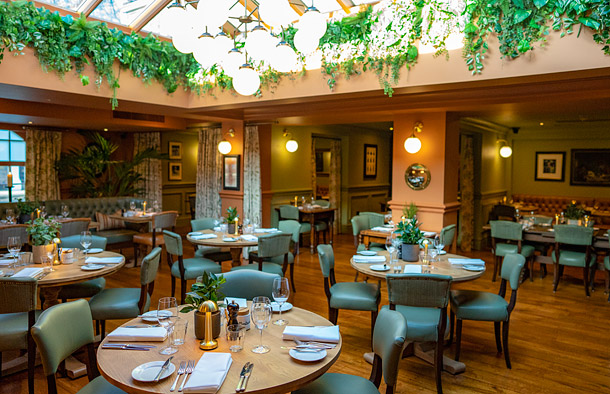
The hotel's 'Bistro du Vin' is a lovely spot for dinner, striking just the right semi-formal note to make you feel relaxed yet special. The food is delicious with a menu that changes with the seasons.
Should you wish to dine out on some evenings of your stay, then all of York's multitudinous array of restaurants are within a short stroll.
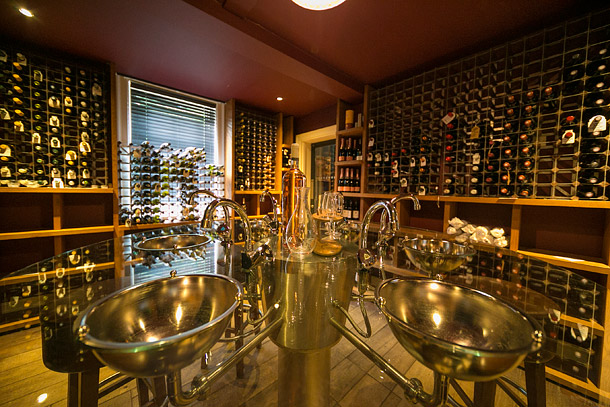
York Golf Clubs
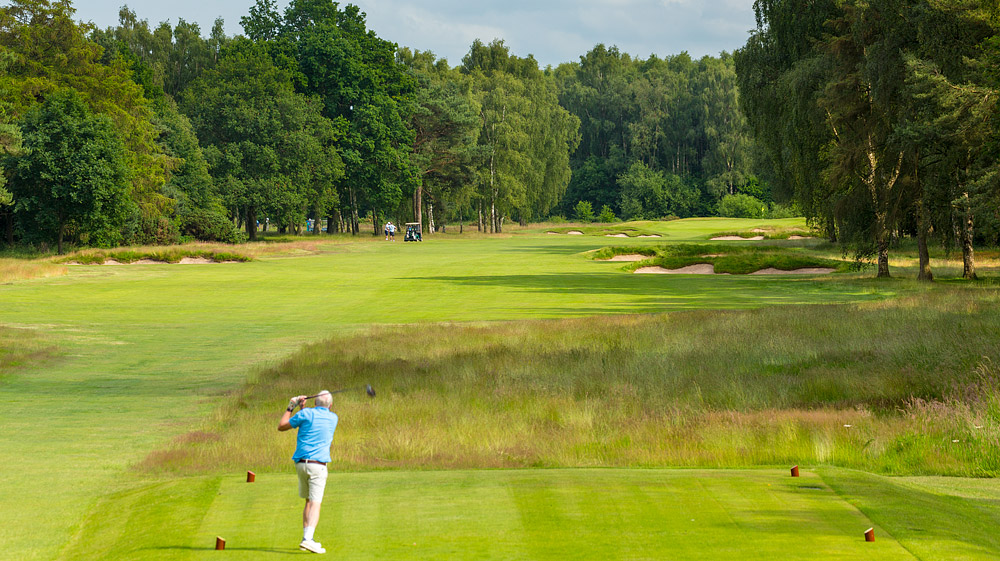 Fulford Architect: C. MacKenzie (1935) 18 holes: 6,100yds: par 72.
Fulford Architect: C. MacKenzie (1935) 18 holes: 6,100yds: par 72.
One of England's finest parkland golf courses, renowned for Bernhard Langer's famous 'tree-iron'. But there is much more to this technical course where position from the Tee is all important: either opening up the Green or sealing it off! Host to a long list of Pro tournaments in the 1900s when the ball didn't go quite as far; it remains a very good test for Club golfers and you are sure to enjoy the quality of the Greens and the warm Yorkshire welcome.

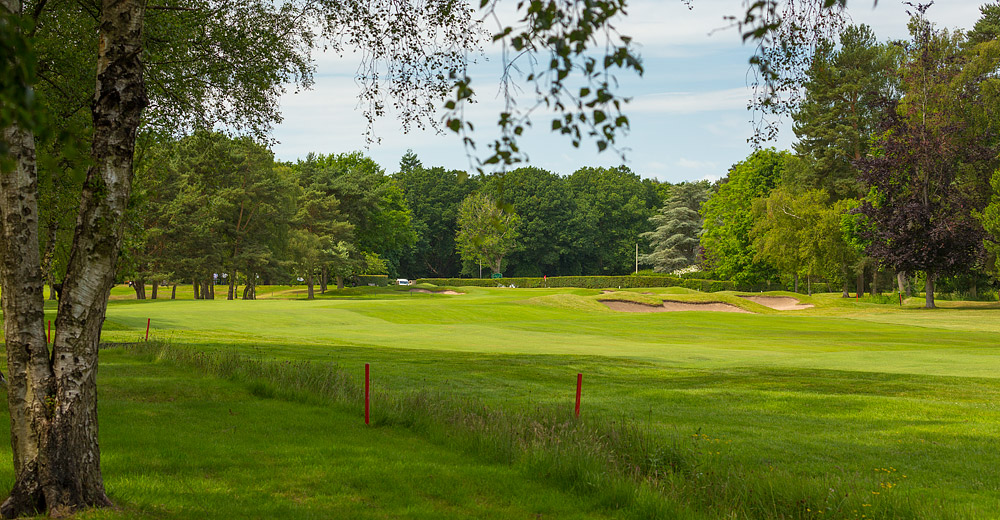 York (Strensall) Architect: J.H. Taylor (1904) 18 holes: 6,367yds: par 70.
York (Strensall) Architect: J.H. Taylor (1904) 18 holes: 6,367yds: par 70.
Another centurion Club, just to the North of York at Strensall, that was crafted by none other than J.H. Taylor whose course designs are not as prolific as other Open champions of his era. The land is a mixture of heath and parkland known as 'lowland heath' (bit like a moor with trees!) one shrub you won't fail to notice is gorse which springs in abundance anywhere there isn't a tree! However, the Fairways are generally generous so barring the odd mishap progress should be steady.

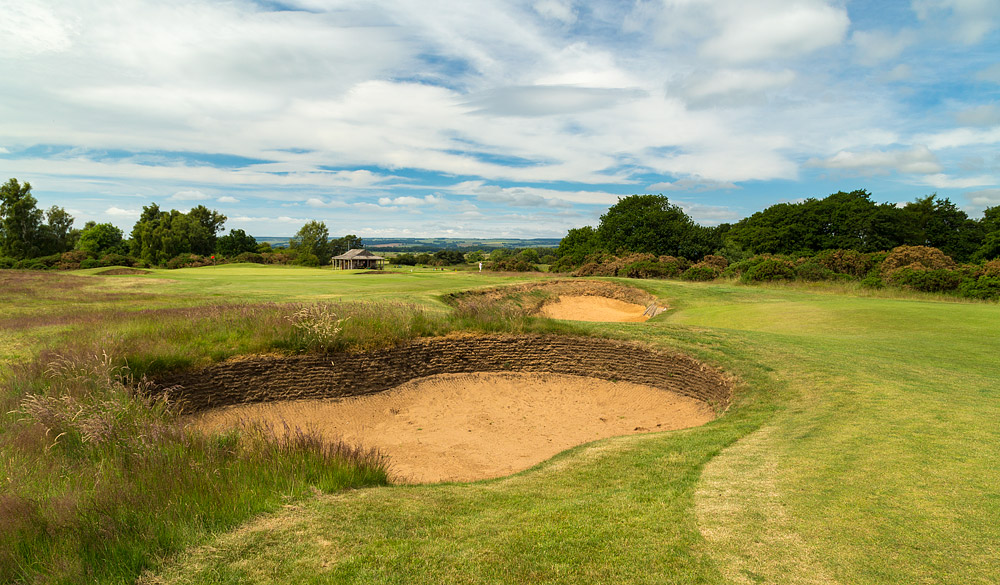 Ganton Architect: T. Dunn (1891) 18 holes: 6,061yds: par 73.
Ganton Architect: T. Dunn (1891) 18 holes: 6,061yds: par 73.
About 45 minutes from York, heading out towards the North Yorkshire coast and the bright lights of Scarborough, hides one of England's finest inland courses - arguably THE finest. A little remote from other golfing clusters in the British Isles, it remains a course that many golfers have heard about: few have played. Despite its inland setting, Ganton has a very linksy feel to it with hardly a tree to be seen around the course. A feeling that is enhanced by firm Fairways and Greens that favour a low-approach between the yawning bunkers. A tough, but rewarding test; well worth the drive from York.

Hotel du Vin - Stratford-upon-Avon
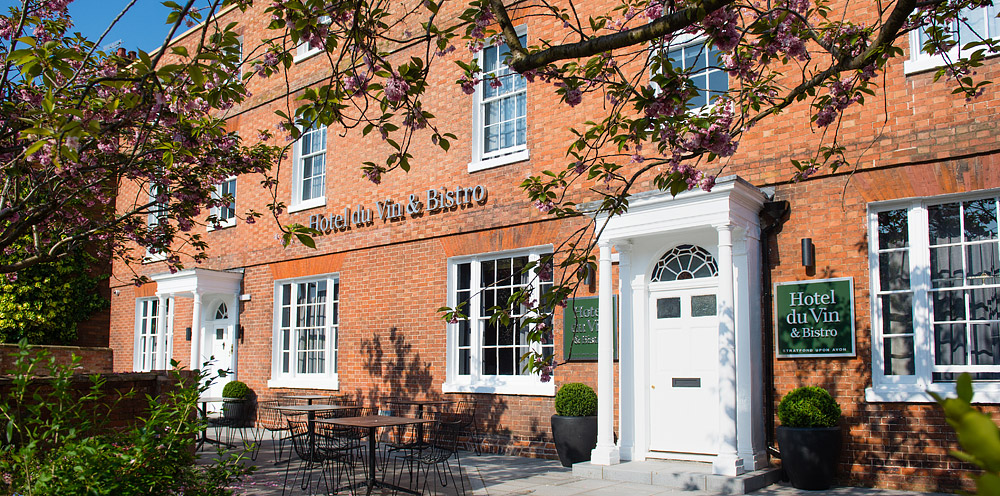
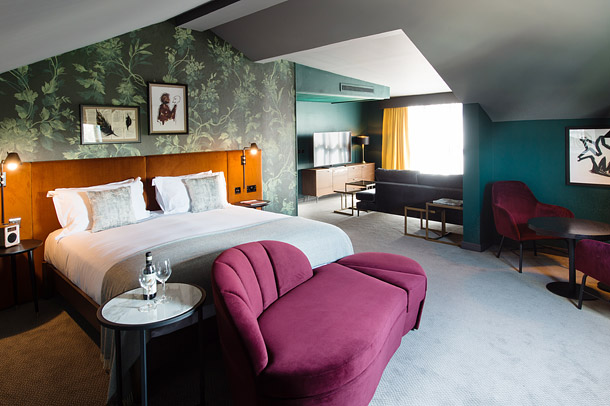
In Shakespeare's home town, a classic redbrick edifice dating back to 1798 that has played many parts in the history of Stratford-upon-Avon including Registry Office and Gentleman's Club! It has now taken on the role of luxury hotel having been given the Hotel du Vin touch, transforming it into the place to stay and play - or catch a play.
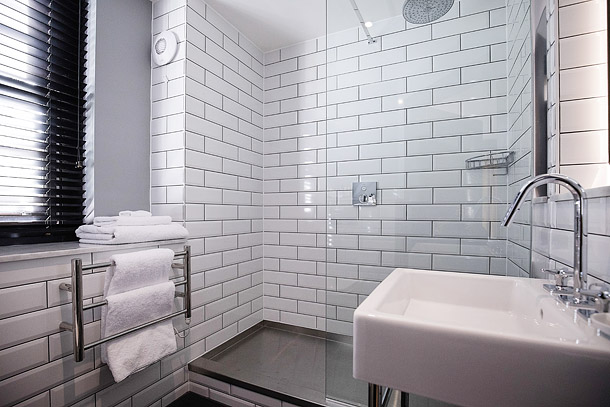
There are 46 rooms and suites at the hotel, all elegantly refurbished and offering the levels of sophisticated comfort that you would expect from the Hotel du Vin group.
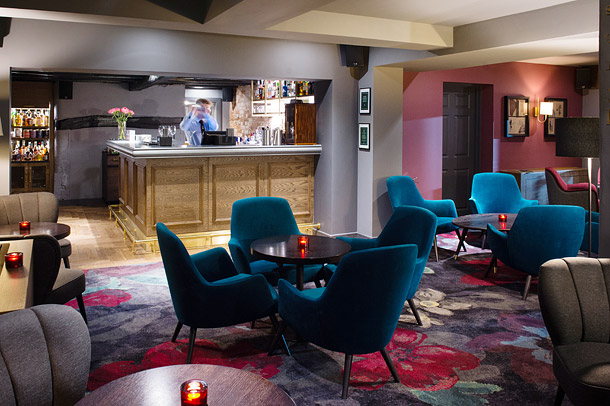
The hotel has an extensive wine-cellar, so you will not be short of suggestions to accompany dinner in the French Bistro or outside on the landscaped garden terrace. There are also private dining rooms if you would like to organise a special dinner for your golfing party?
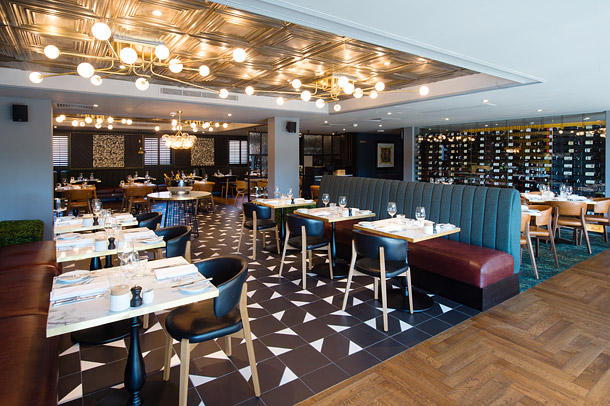
For sightseeing or dining out the centre of Stratford is only minutes away on foot. Getting to the golf courses is easy too, half-a-dozen of them lie just half-an-hour from your front door.
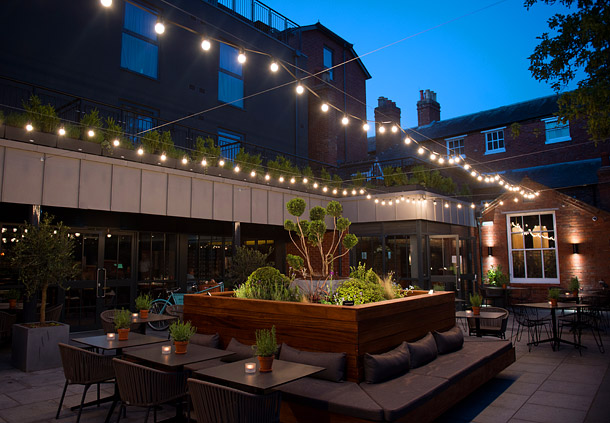

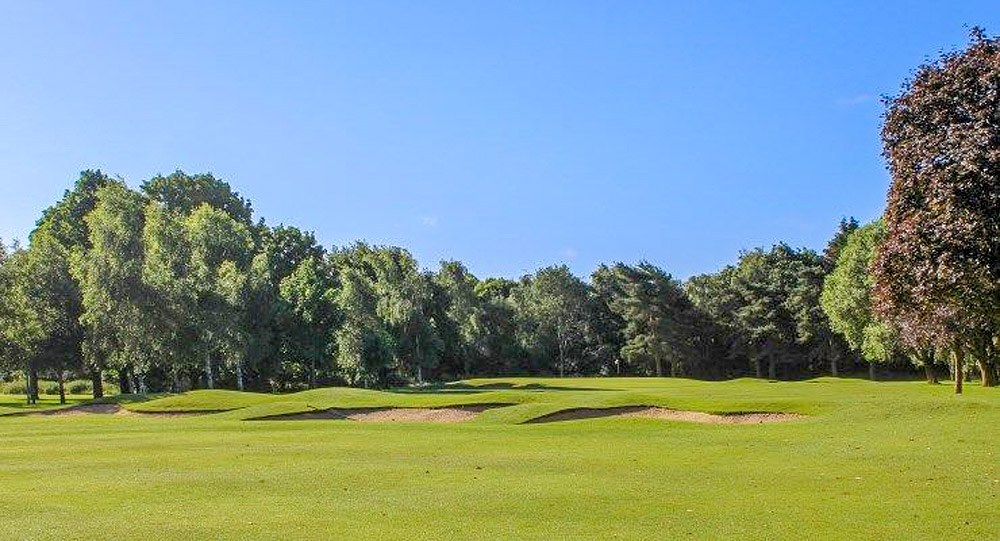 Stratford upon Avon Architect: (1940) 18 holes: 6,278yds: par 72.
Stratford upon Avon Architect: (1940) 18 holes: 6,278yds: par 72.
The club in the centre of town, so the easiest to get to from the central Stratford-upon-Avon hotels. Level, parkland golf with thick avenues of trees separating the holes from one another.

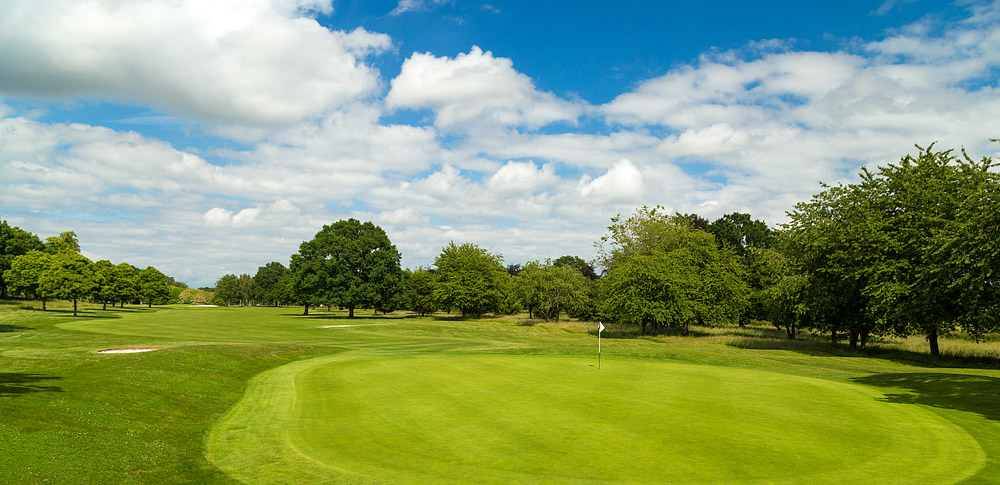 The Welcombe Stratford Architect: 18 holes: 6,149yds: par 70.
The Welcombe Stratford Architect: 18 holes: 6,149yds: par 70.
Attached to a large resort hotel (The Welcombe) just outside Stratford-upon-Avon, one of the most varied of the Stratford courses due to the nature of the terrain: a few hills amid the dense forest of the old stately home provide some pleasant views and club selection ponders! A lot of residents at The Welcombe hotel stay for the spa, so there is plenty of availability out on the course, which has its own entrance and Clubhouse (curiously positioned beside the practice ground).

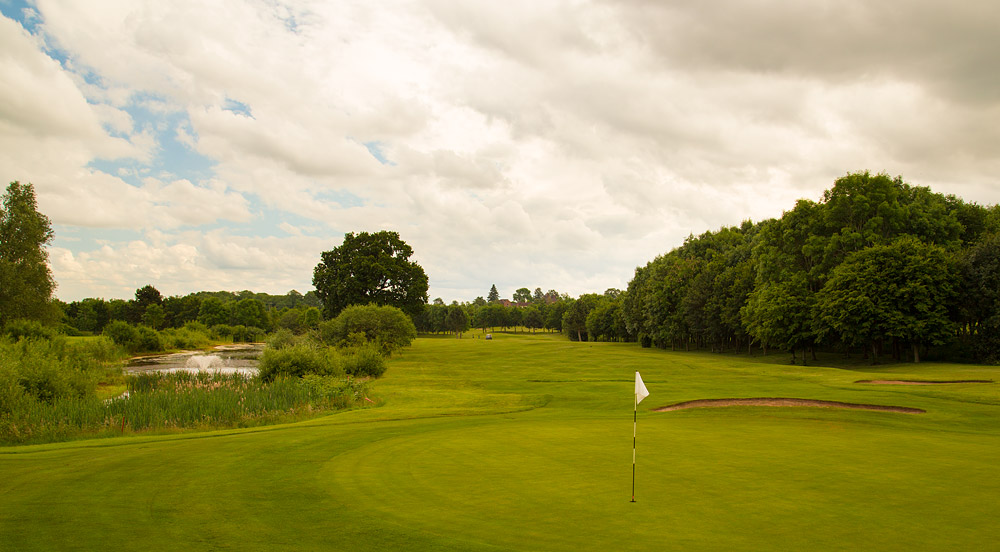 Stratford Park Architect: 18 holes: 6,502yds: par 72.
Stratford Park Architect: 18 holes: 6,502yds: par 72.
Sitting right beside the Welcombe (you might think they were the same Club) yet on slightly smoother land, Stratford Park is a more recent addition to the Stratford golf scene and a more commercial set-up. The course is heavily wooded yet very playable and there is always plenty af activity around the Clubhouse with its small hotel and function rooms.

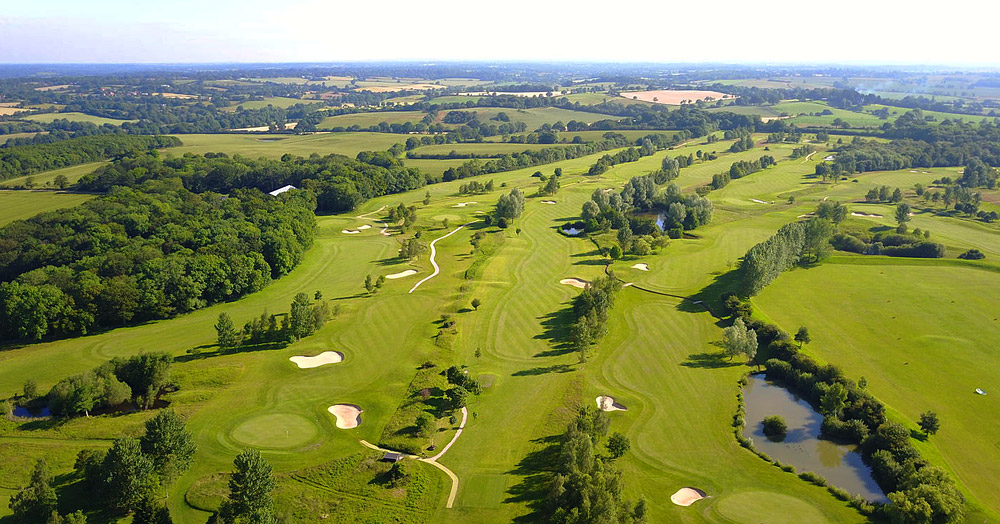 Stratford Oaks Architect: 18 holes: 6,232yds: par 71.
Stratford Oaks Architect: 18 holes: 6,232yds: par 71.
An easily accessible course that welcomes all varieties of golfer due to its 'pay-and-play' set-up. A very natural area of English countryside with hardly a building in sight (even the Clubhouse is just a simple wooden affair) gives Stratford Oaks a nature reserve feel (more ducks than golfers when we visited!). Great for a warm-up round or for fledgling golfers to spread their wings in a no-pressure environment.

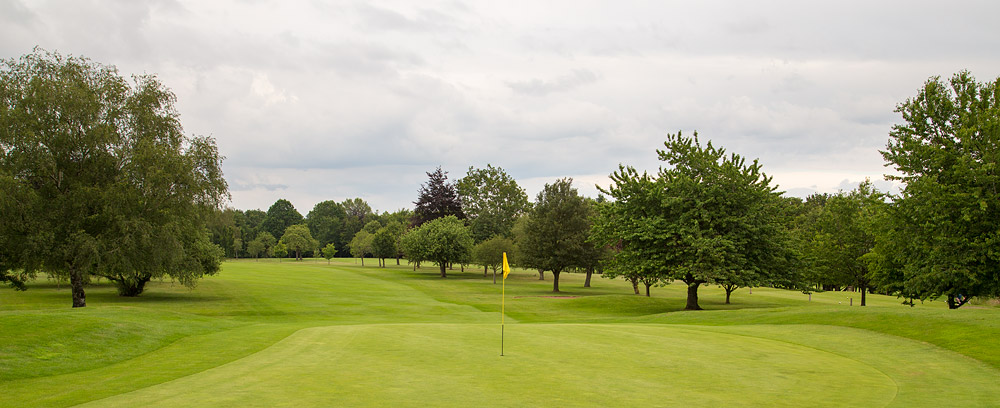 Kenilworth Architect: 18 holes: 6,285yds: par 71.
Kenilworth Architect: 18 holes: 6,285yds: par 71.
A modern members Club that is very welcoming to the roving golfer. Their woodland course is good fun without being overly-taxing - probably why they're so popular!

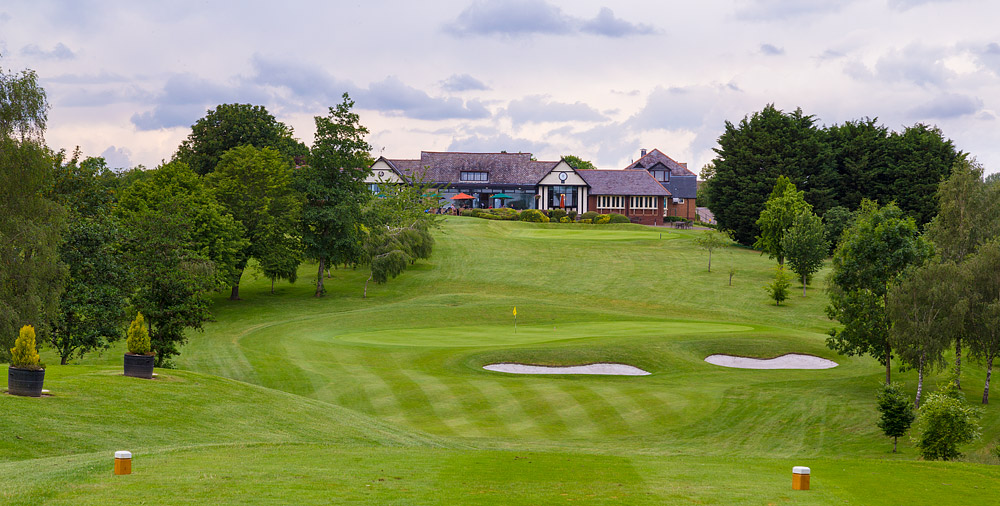 Leamington & County Architect: 18 holes: 6,403yds: par 72.
Leamington & County Architect: 18 holes: 6,403yds: par 72.
A long-standing private Club with a delightfully traditional Clubhouse and warm welcome to visiting golfers. Leamington & County has a course that rides the hillsides around the Clubhouse providing entertaining and thought-provoking golf.

Other courses to consider
Broadway Architect: 18 holes: yds: par 72.
Simple set-up with wonderful Cotswolds views.
Copt Heath Architect: H. Vardon & H.S. Colt (1907) 18 holes: yds: par 72. Outstanding heathland golf from a great golfer and a great designer.
Coventry Architect: 18 holes: yds: par 72. Popular private Club; always busy due to its proximity to the big city of the same name.
Hotel du Vin - St. Andrews

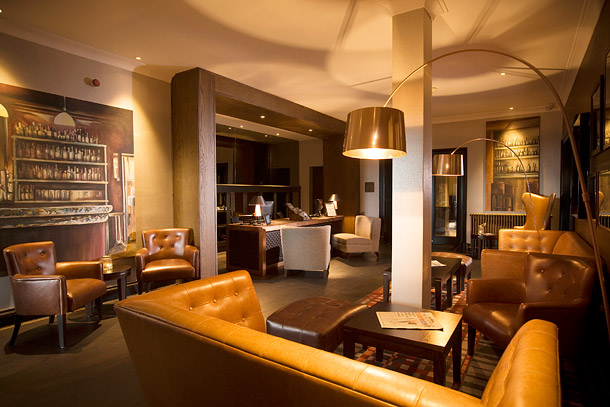
Is there a better location in St. Andrews than on the Scores right behind the R&A Clubhouse?
From your bedroom window you can watch the golfers and the tide come in and go out around the auld grey toon.
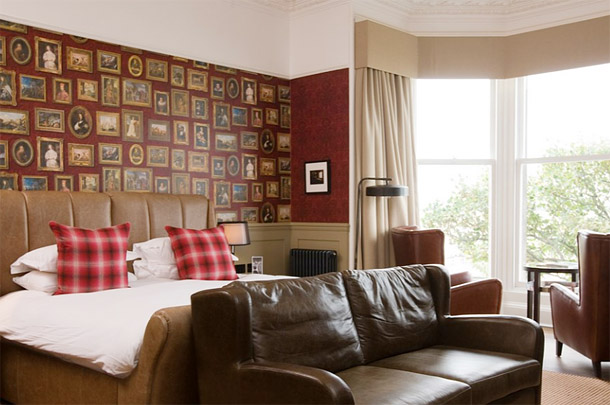
The Saint Andrews Hotel du Vin occupies two of the fine old stone mansions that typify the architecture of the capital of golf. Beautifully refurbished, the stylish modern interior contrasts wonderfully with the stern grey exterior.
Bedrooms are very comfortable; treat yourself to a sea-view room for the finest vista in town.

When it comes to refreshments you will be spoiled for choice: the Hotel du Vin has an hotel bar plus its own pub "Ma Bells": allowing you a choice of settings for your post-round analysis.

For dining, the hotel's 'Bistro du Vin' is a lovely
spot, with a Scottish twist to the brasserie style cuisine that characterises the Bistro du Vin epicurean philosophy.
For dining out, St. Andrews has plenty more options and we shall recommend a few of our favourites to you that are well within walking distance.


St. Andrews Golf Courses
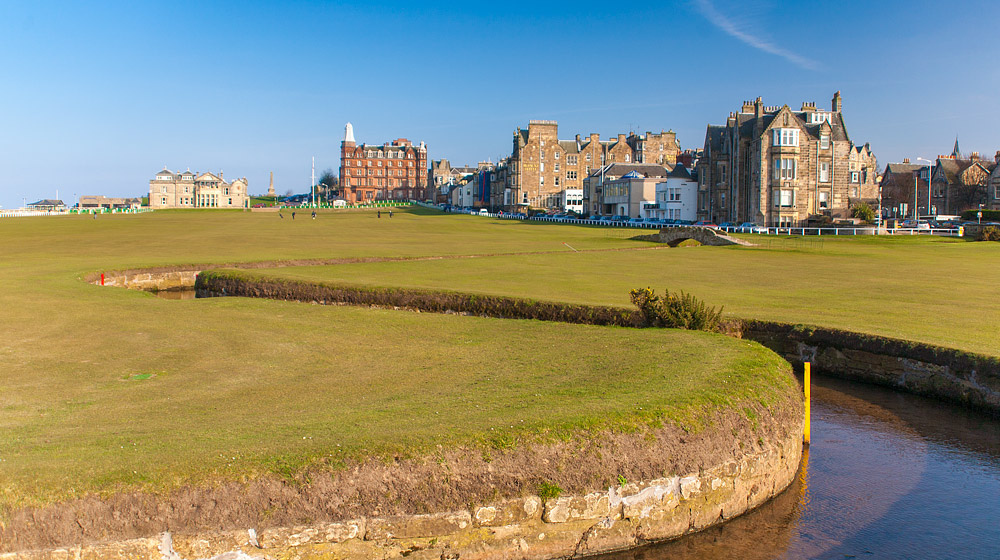 St. Andrews
- Old Course Architect: Evolution (1754 onwards) 18 holes: 6,041yds: par 72.
St. Andrews
- Old Course Architect: Evolution (1754 onwards) 18 holes: 6,041yds: par 72.
The original and to many
still the finest. The history attached to the oldest links in golf is unlike any other and all
golfers owe it to themselves to play here at least once in their lifetime. That
said, the course does take some getting to know. Bear in mind that it was built to be played in both directions (clockwise and anti-clockwise
circuit) so many hazards seem randomly placed unless looked at heading in the opposite direction. For this reason Caddies are advisable for
your first round as the direction of play is not always obvious from the Tee. Pay close attention too to the colour of
the flags on the many double greens: playing to the wrong one can leave you huge putts that can be harder to read than Chaucer. All in all:
an experience you will never forget.
N.B. There is a daily ballot
for Tee-times (we shall arrange for your names to be entered into the ballot) and no play is allowed on Sundays.

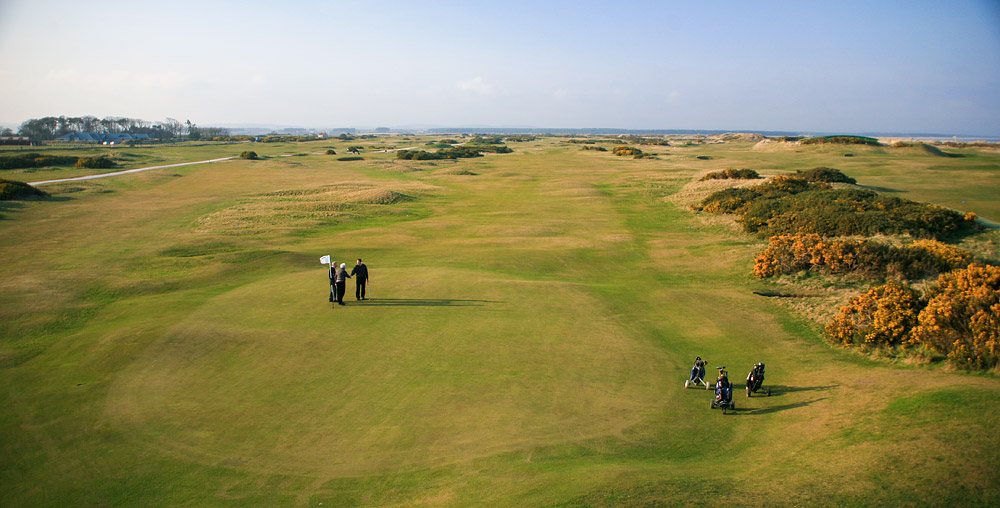 st. Andrews
- New Course Architect: Old Tom Morris (1895) 18 holes: 6,036yds: par 71.
st. Andrews
- New Course Architect: Old Tom Morris (1895) 18 holes: 6,036yds: par 71.
Considered by more than a few locals to be the best of
the collection
of courses at St. Andrews. The hundred year old New Course
runs alongside the Old,but has a more classical links design being
thought out rather than just allowed to happen.
The bunkers are more strategically placed and the preferred route to
the cup more easily discerned. As with nearly all links courses,
mastery of the bump and run shot around the hard fast Greens will pay
dividends. St. Andrews New shares a Clubhouse with the Jubilee course,
which becomes home base for many visiting golfers.

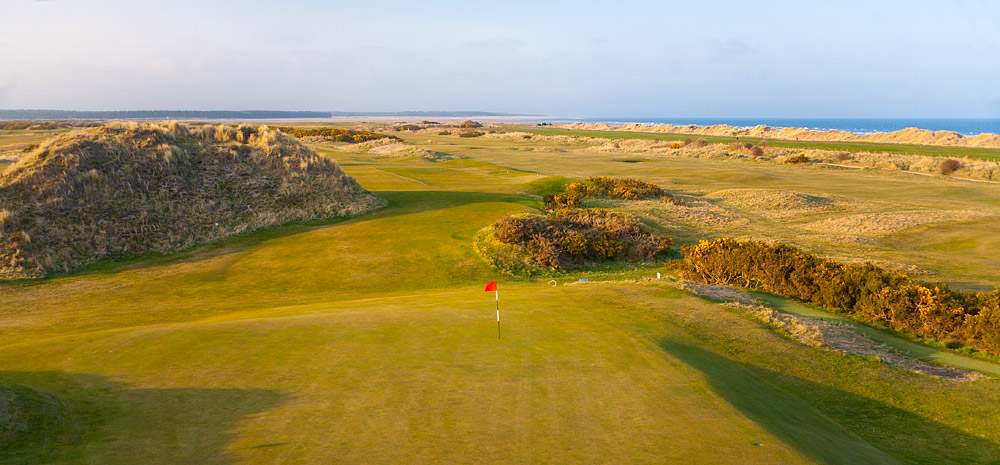 St. Andrews - Jubilee Course Architect: Old Tom Morris (1897) 18 holes: 6,162yds: par 72.
St. Andrews - Jubilee Course Architect: Old Tom Morris (1897) 18 holes: 6,162yds: par 72.
The
Jubilee course is the longest in the St. Andrews links course stable and the closest to the sea; consequently also the breeziest and
with the largest dunes. Here the land has returned from the North Sea in the last couple of hundred years so the going is very sandy underfoot
and the more pronounced dunes are smothered in plumes of Marram grasses as opposed to the more predominant Furze (aka Gorse) of the New
and Old courses that lie to the inland side. A fine links course in all respects with the water in view from almost every hole - and always
within earshot. The Jubilee was given a minor facelift for its centenary in 1997 and is now a perfect complement to the other courses governed by the St. Andrews Links Trust.

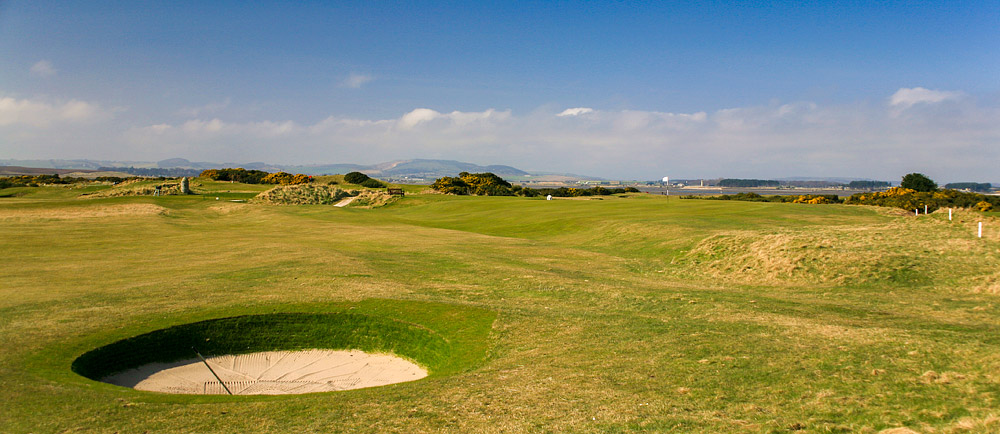 St. Andrews
- Eden Course Architect: Harry Colt (1914) 18 holes: 5,662yds: par 70.
St. Andrews
- Eden Course Architect: Harry Colt (1914) 18 holes: 5,662yds: par 70.
The shortest of the St. Andrews collection, yet still exhibiting
all the intricate demands of a true links. For many of the locals and Members this is their favourite with a nice balance of length
and trouble it is never too taxing but shoddy shots are punished so keeping you on your guard. A great course on which
to start your week and hone your links skills of low shots into the wind, running the ball up to the flag on firm Greens,
escaping from deep bunkers and staring into gorse bushes...

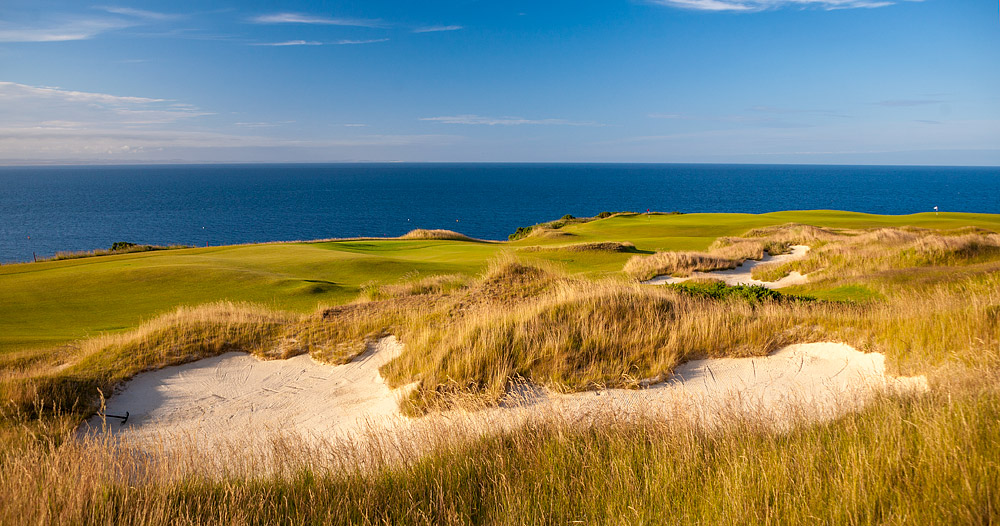 St. Andrews
- Castle Course Architect: D. McLay Kidd (2008) 18 holes: 7,188yds: par 71.
St. Andrews
- Castle Course Architect: D. McLay Kidd (2008) 18 holes: 7,188yds: par 71.
The Castle Course is the latest addition to the St. Andrews
portfolio, opening in the Spring of 2008. It is totally different to the other St. Andrews Links Trust courses in that it lies on elevated
land outside the town (on the way around to St. Andrews Bay) and has much more of a resort course feel about it. Bunkers are convoluted in
shape rather than oval and deep: the terrain rises and falls gently rather than the level linksland of the Old Course et al. From
all over the Castle Course you will enjoy superb views of the cathedral and town and away over the mouth of the Tay to Carnoustie on the far
side. A superb course and setting that contrasts nicely with St. Andrews' four pure links courses.

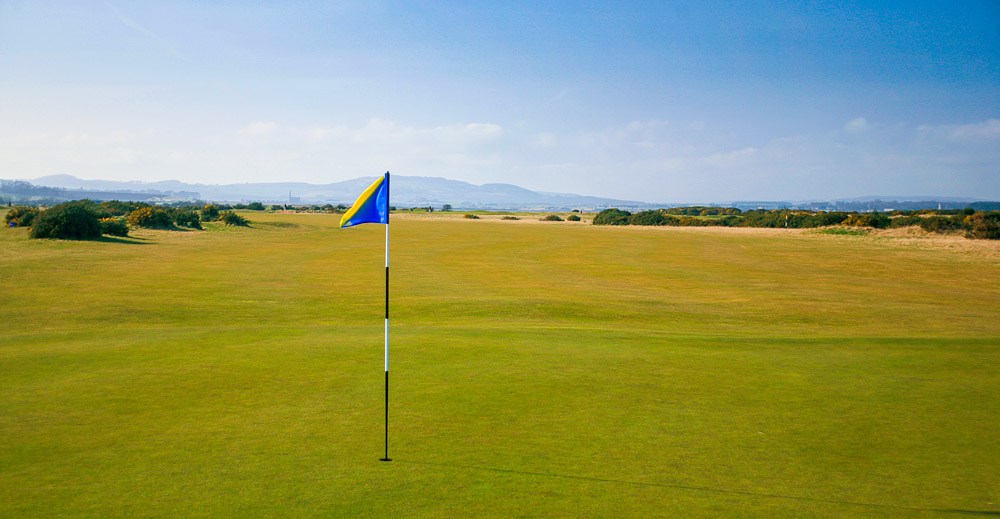 St. Andrews
- Strathtyrum Course Architect: Harry Colt (1914) 18 holes: 5,662yds: par 70.
St. Andrews
- Strathtyrum Course Architect: Harry Colt (1914) 18 holes: 5,662yds: par 70.
Nice and open and encouraging the swish of the Driver. The Strathtyrum course is by far the least taxing of those
that St. Andrews has to offer. Perfect for a brisk warm-up round on the day that you arrive or an afternoon's post prandial outing or for your
first taste of links golf - so different from the inland version of the game.
Shares a Clubhouse with the Eden course.

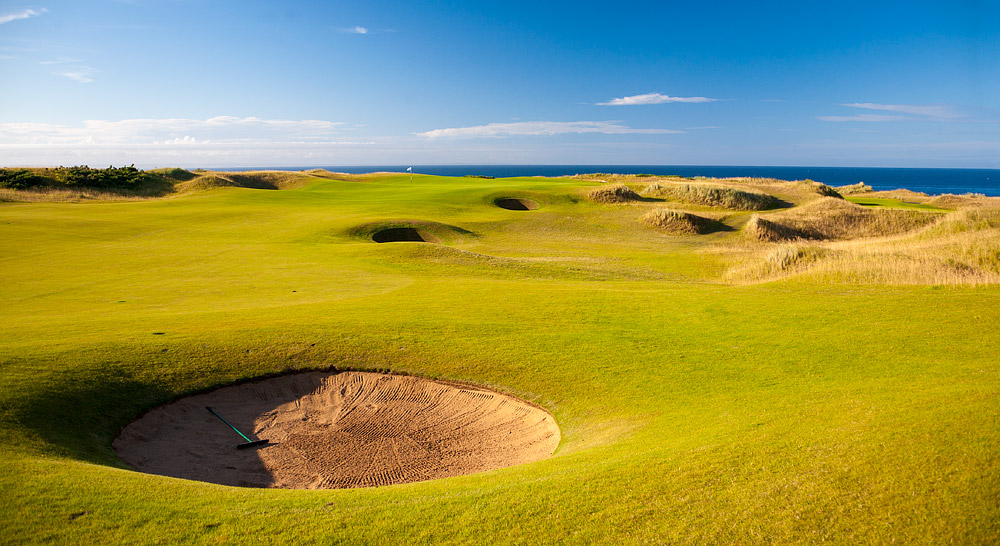 Kingsbarns Architect: K. Phillips (2001) 18 holes: 6,414yds: par 72.
Kingsbarns Architect: K. Phillips (2001) 18 holes: 6,414yds: par 72.
Given a rather impressive stretch of coastline to begin with the job
for Kyle Phillips was not to ruin it, don't worry, he didn't!
Kingsbarns has the look and feel of a course that has been embedded into
the landscape since time immemorial and is a joy to behold. With a
hefty Green-fee, the target market is clearly American.

Just around the corner from St. Andrews are two very accessible (i.e. pre-bookable) courses at the St. Andrews Bay resort.
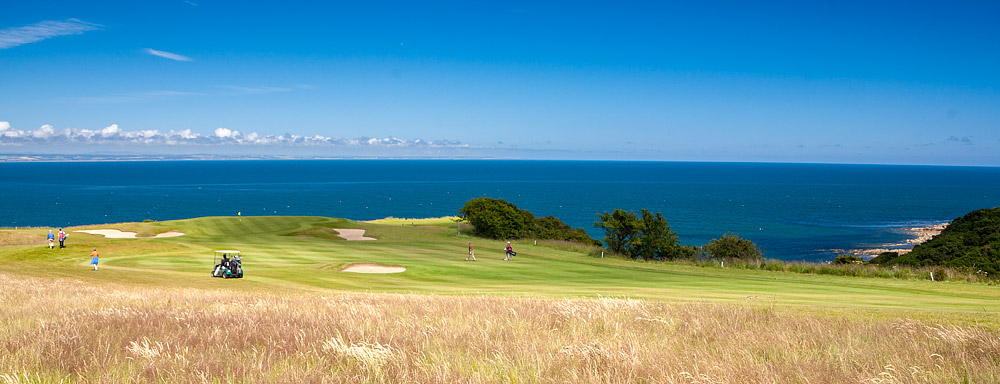 St. Andrews Bay
- Kittocks Architect: B. Devlin (2000) 18 holes: 7,049yds: par 72.
St. Andrews Bay
- Kittocks Architect: B. Devlin (2000) 18 holes: 7,049yds: par 72.
The most scenic of the two St. Andrews Bay courses on a stretch of land bordering the coast all the way along. Indeed Gene
Sarazen likened the views to Pebble Beach when he visited the site of the future course. Within the boundaries of the course lies Kittocks
Den a nature reserve, so you are sure to catch sight of plenty of indigenous wildlife during the course of your round.
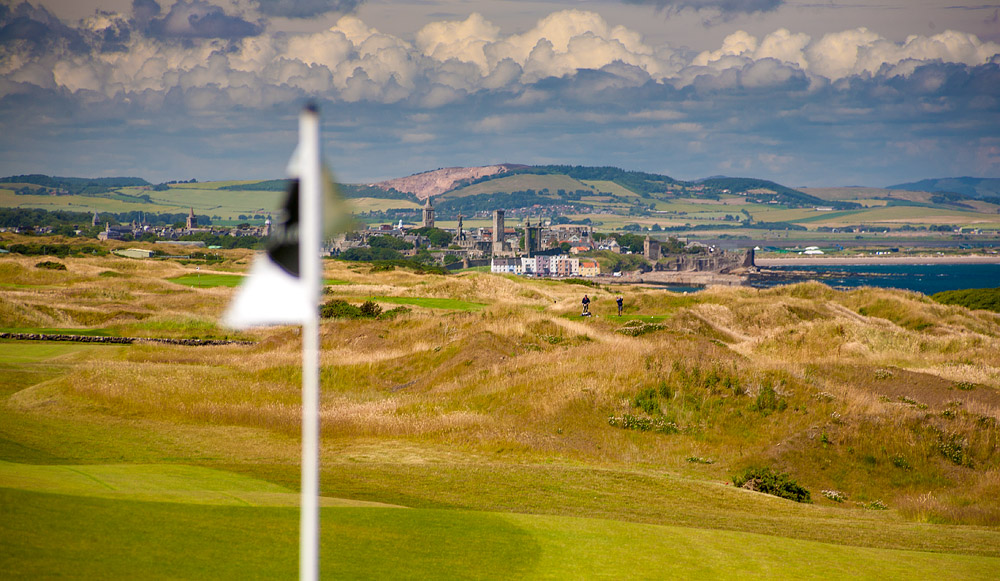 St. Andrews Bay
- Torrance Architect: S. Torrance (2001) 18 holes: 7,012yds: par 72.
St. Andrews Bay
- Torrance Architect: S. Torrance (2001) 18 holes: 7,012yds: par 72.
Most of the holes lies to the inland side of Kittocks - but
only by a matter of a few hundred yards so the majestic coastline is
ever present as a backdrop to your game. The original Sam Torrance
design has been re-worked with new Tees on every hole, additional
hazards and a couple of holes swapped between the courses. All of which
makes the Torrance the sterner test of golf.

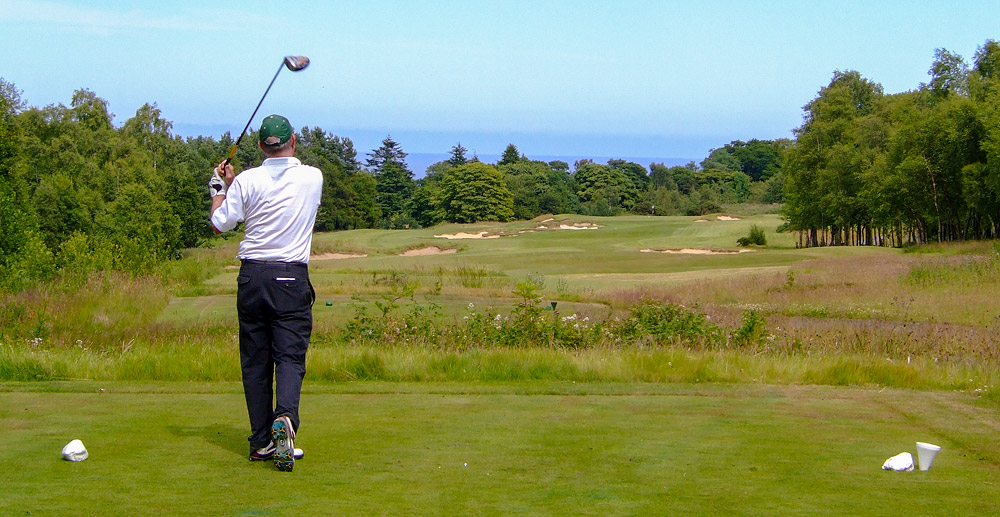 St. Andrews
- Dukes's Course Architect: Harry Colt (1988) 18 holes: 5,662yds: par 70.
St. Andrews
- Dukes's Course Architect: Harry Colt (1988) 18 holes: 5,662yds: par 70.
A striking contrast to all of the other St. Andrews golf
courses in that it doesn't border the sea. Instead, the Duke's Course
(which is owned and operated by the Old Course Hotel) sits around a
small hill about a mile inland form the town. Much more of a US style
course (it is twinned with Whistling Straits in Wisconsin) with it's
rough-cut bunkers and buggy path (it's quite hilly in places). The
closing holes were re-routed in 2000 and have made the overall flow of
the course much better. A lovely Clubhouse atop the hill completes a
very pretty picture.

Edinburgh
Coming soon...






